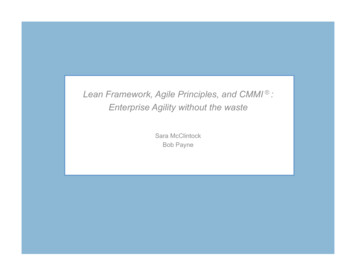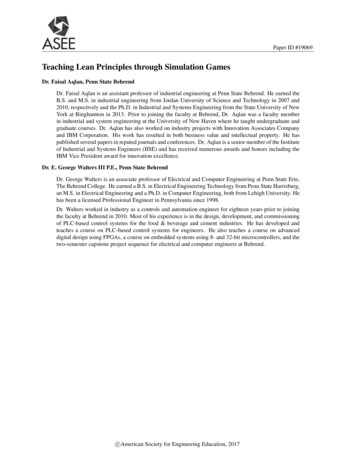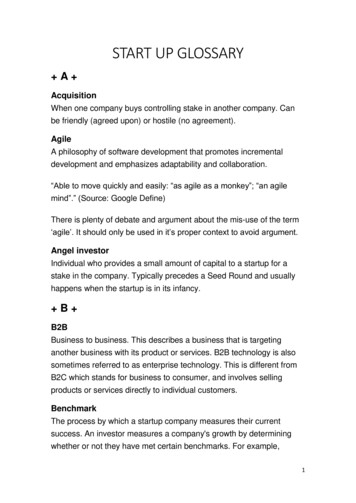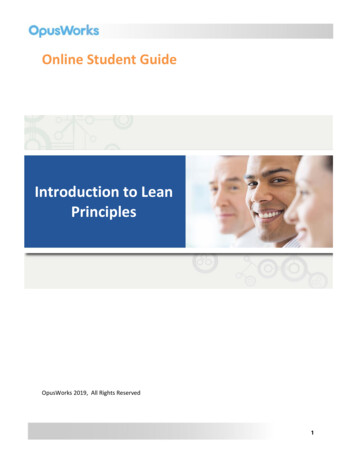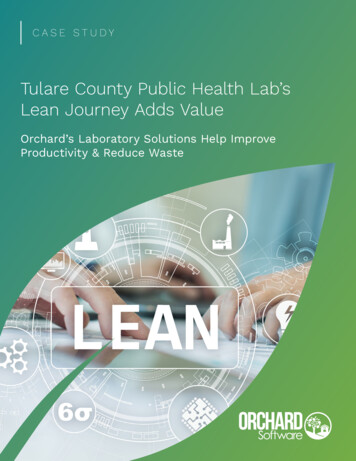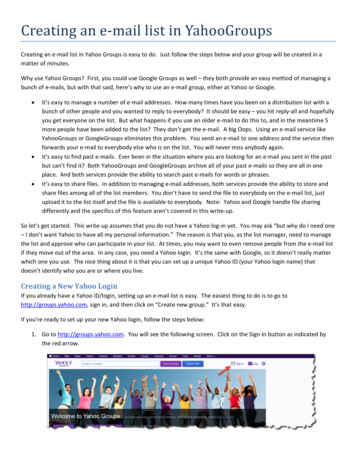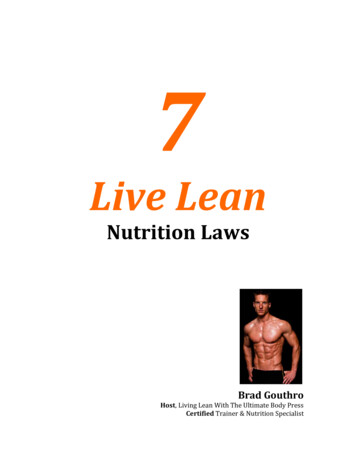
Transcription
7Live LeanNutrition LawsBrad GouthroHost, Living Lean With The Ultimate Body PressCertified Trainer & Nutrition Specialist
Live Lean Nutrition Law #1Set A Measurable & Realistic GoalMost people come to me and say “Brad, I need to lose 10 lbs before summer in 2 months.”That's a great start. You have a set measurable goal 10 lbs in 8 weeks. But is thisrealistic (and healthy)?Typically, a healthy fat loss plan will allow you to lose 1-2 pounds of fat per week withexercise and a nutrition plan that puts you in a caloric deficit. A caloric deficit simplymeans you're burning more calories than you're eating.However, everyone's calorie requirements are different based on your current bodycomposition and activity levels. Lets take a closer look.How many calories should I be eating to lose fat?Going into a severe calorie deficit through dieting alone IS NOT the most effectiveapproach. Not only is this crash diet unhealthy and unsustainable, your body will also gointo starvation mode. This means it’ll end up storing fat and burning your muscle forfuel. This loss of muscle slows your metabolism and adds up to a “lighter” but fatterversion of your current self. Heard of the term “skinny fat” well that’s what happens oncrash diets.The two healthiest ways to create a calorie deficit is by following a diet that puts you ina modest caloric deficit AND THEN follow that up with an intense exercise program tocreate an even higher caloric deficit.But before we can figure out how we can be in a caloric deficit, we first need tocalculate how many calories our body actually requires (to maintain current size) basedon our specific body type.Follow the quick steps below to begin your calculations.Step #1: Calculate your body fat %.This can be done using body fat calipers or a simple handheld body fat analyzer. Ask atrainer at your gym for help.For this example, lets say your body fat analysis 20%
Step #2: Calculate your lean body mass.Lean Body Mass Current weight - (Current body fat % x Current weight)For this example, lets say your weight 190 lbsLean Body Mass 190 – (.20 x 190) 152 lbsLean Body Mass 152 lbsStep #3: Calculate your maintenance calories.This step calculates the amount of calories you need to MAINTAIN your current weight.For this example:Your body fat % was 20.Your lean body mass was 152 lbs.Based on the chart below, your maintenance calories would be calculated as:14 calories x 152 lbs 2,128 caloriesCurrent Body Fat %Up to 12%12.1-15%15.1-19%19.1-22%22.1% & aboveMaintenance Calories Formula17 calories x Lean Body Mass (in lbs)16 calories x Lean Body Mass (in lbs)15 calories x Lean Body Mass (in lbs)14 calories x Lean Body Mass (in lbs)13 calories x Lean Body Mass (in lbs)Step #4: Calculate your calorie requirements to lose fat effectively.Rather than trying force fat loss by creating a substantial caloric deficit, to live lean it’srecommended to coax fat loss by focusing on eating REAL WHOLE FOODS and followinga modest caloric deficit in the range of 250 calories per day. Based on this, your caloriegoal per day would be:Daily calorie goal Daily calorie maintenance – Daily modest calorie deficit2,128 – 250 1,878 caloriesSo there you go.
You just calculated that 1,878 calories is your daily calorie goal to lose fat effectively.Does this mean you can eat any food you want just as long as by the end of the dayyou’ve consumed a total of 1,878 calories?No!The quality of the calories is also very important. Keep reading.How Many Of Those Calories Should Come From Protein,Carbohydrates, & Fat?Step #5: Calculate your protein intake requirements.Protein intake 1.15-1.5 grams per pound of lean body mass. Start on the low side (1.15grams). If you find yourself very hungry throughout the day, increase this number up to1.5 grams).For this example, your lean body mass 152 lbs.Starting protein intake 1.15 x 152 175 grams of protein1 gram of protein 4 calories. Total calories from protein 700 calories from proteinStep #6: Calculate your carb intake requirements.Do you notice you gain fat easily when you eat carbs? If so, you may be insulin resistant.If this is the case, limit carb intake to .5 grams per pound of lean body mass. However, ifcarbs don’t negatively affect you, you can increase that intake up to .75 grams perpound of lean body mass.For this example, we’ll say you are not insulin resistant, so your carb intake is .75 gramsper pound of lean body mass.Carb intake .75 x 152 114 grams of carbohydrates1 gram of carbohydrates 4 calories. Total calories from carbohydrates 456 caloriesfrom carbohydrates
Step #7: Calculate your fat intake requirements.The remaining calories will come from healthy sources of dietary fat. You may think thissounds like a lot of fat, but healthy sources of fat are essential to your body’s hormonalsystem. Healthy sources of dietary fat ARE NOT bad.For this example:Calories from protein 700Calories from carbohydrates 456Equals total of 1,156 caloriesCalories requirement 1,8781,878 calories – 1,156 calories 722 calories from fat1 gram of fat 9 calories. Total calories from fat 722 calories722/9 80 grams of fatThat’s How You Calculate How Many Calories, Protein,Carbohydrates, & Fat You Need.Note:If you’re NOT looking to lose fat or gain anymore muscle. Use the same steps, but justuse your “calorie maintenance” number. Not the “calorie maintenance – daily caloriedeficit” number.If you’re looking to ADD more muscle, rather than subtracting 250 calories from yourcalorie maintenance number, add 250 calories to it.
Live Lean Nutrition Law #2Eat Real FoodWhen it comes to real food, think Fred Flintstone. Not George Jetson.Your genetic makeup is 99% the same as your Paleolithic ancestors from thousandsof years ago.These ancestors thrived on a diet comprised of animals and plants. Not cookies andCoca-Cola.To put it simply, your digestive system and body as a whole was made to assimilate,absorb, and thrive on specific Paleolithic foods.These foods are natural. These foods are whole. And in most cases, these foodscontain ONE INGREDIENT!This is the difference between FOOD and PRODUCTS. Foods are from the earth.Products are created in a factory using cardboard boxes.
Products are filled with chemicals, artificial sweeteners, preservatives, refinedsugar, and man-made hydrogenated or vegetable oils.Next time you go grocery shopping, take note of what aisles you’re spending most ofyour time in. Typically, whole natural, one-ingredient foods are located on theperimeter of the grocery store. All the unnatural processed foods are usually foundin the middle aisles.And please don’t fall for the “low calorie” marketing hype.If your food is marketed as low calorie, comes in a box, and contains more than 1ingredient, it’s hype not nutrition.I know, it sounds confusing.Fortunately, we have you covered. Just print out the grocery list below, take it to thegrocery store, purchase the items, and get ready to live lean.Your Grocery List To Live LeanProtein BisonChickenClamsCodCrab MeatEggs (Whole)Egg WhitesExtra Lean Ground BeefGround LambGround PorkGround TurkeyHaddockHalibutLambMahi MahiMusselsPorkSalmon (Wild, Fresh, Canned, & Smoked)ScallopsShrimp
SteakTilapiaTuna (Fresh & Canned)Whey Protein PowderVeggies ArgulaArtichoke HeartsAsparagusBell Peppers (Red, Green, Orange, & Roasted Red Pepper)BroccoliBok ChoyBrussels SproutsButternut SquashCabbageCarrotsCauliflowerCeleryCherry TomatoesCucumberEggplantEndivesFennelFriseeGreen BeansGreen OnionHot Peppers (Jalapeño & Chilies)KaleLeeksMushrooms (Whole, Portobello, & Shiitake)Onions (Red & Yellow)PeasRadishesRoasted Red PepperRomaineRutabagasSauerkrautShallotSnow PeasSpaghetti Squash
SpinachStrawberriesTomatoes (Fresh, Canned Diced Tomatoes, & Tomato Paste)TurnipZucchiniHealthy Fats Almonds (Unsalted)Almond ButterAvocadosCashews (Unsalted)Coconut OilCoconut (Shredded/Unsweetened)Fish OilGround Flax SeedHazelnutsHazelnut OilMacadamia Nuts (Unsalted)OlivesOlive OilPecans (Unsalted)Pine NutsPistachios (Unsalted)Sesame OilSesame SeedsTahiniWalnuts (Unsalted)Walnut OilCarbohydrates & Fruit ApplesBananasBlueberriesCoconut FlourCranberries (Dried)DatesHoney (Raw)
JicamaLemonLimeMangoMaple Syrup (Pure)OrangePineappleRaspberriesSweet PotatoesCondiments Apple Cider VinegarBalsamic VinegarBeef Broth (low sodium)Chicken Broth (low sodium)Fish SauceHot SauceMustardRed Wine VinegarRice Wine VinegarSalsaSherry VinegarTamariVanilla Extract (pure)White Wine VinegarHerbs & Spices (just buy a spice rack) AllspiceBasilBay LeavesBlack PepperCardamomCayenne PepperChili PowderChivesCilantroCinnamonPure Cocoa Powder
Curry tmegOnion PowderOreganoPaprikaParsleyRed Pepper FlakesRosemarySaffronSageSea SaltSteviaTarragonThymeTumericLiquids Almond MilkCoconut Milk (Prefer Canned)CoffeeEspressoTeaWaterIn Moderation BaconButterChorizo (cured salami)Feta CheeseGoat CheeseGreek Yogurt
Dark chocolate (70% cocoa)Mozza CheeseOatsPotatoesQuinoaSausagesLive Lean Nutrition Law #3Portion SizesIf you follow Live Lean Nutrition #2 you will experience amazing results.However, at the end of the day (or week), if you’re in a caloric surplus (taking in morecalories than you’re burning), you can still add on the pounds.Note: by following a whole foods diet, you’d have a hard time overeating due to thesatiating nature of protein and healthy fats. In other words, you’ll won’t feel as hungry.Regardless, I have a very simple method to ensure your portion sizes are not blowingyour calorie intake out of proportion.
#1. Visualize a dinner plate.#2. Visualize the plate split into 3 sections.#3. Section one is dedicated to your protein source (see grocery list via the previouspages for healthy sources of protein). For every meal or snack, you should have aprotein source. A typical serving size of protein per meal is 3-4 oz. Of course, thequantity should be customized to your calorie requirements, but lets use 3-4 oz as anexample. 3-4 oz of a chicken breast or steak is essentially the size of a deck of cards, orthe palm of your hand. That should take up approximately ¼ of your dinner plate (asseen above).#4. Next, add a whole bunch of non-starchy veggies (think the colors of the rainbow).Veggies like spinach, kale, and bell peppers are considered FREE FOOD. Load up! Thisshould take up pretty much the remaining ¾ of your plate.#5. Top the veggies with a serving of healthy fats (see grocery list for healthy fatsources). You could top your salad with a serving of almonds. When it comes to nuts, asmall handful is considered a serving (1 oz). Or top your salad with a tbsp. of extra virginolive. Healthy fats NEED to be a part of your diet. DO NOT FEAR HEALTHY FATS!This quick and simple method to determine portion sizes will ensure your meals are fullof muscle building proteins, vitamin and mineral packed veggies, and of coursesatiating/hormonal friendly healthy fats.
Live Lean Nutrition Law #4Eat More FrequentlyOne issue people tend to have is they do not eat frequently enough.Here’s a simple example of what happens when people fail to eat:1. Your blood sugar levels crash.2. This creates that animalistic hunger where you just want a quick sugar fix. I’mtalking nasty, belly busting “foods” like chips, cookies, and crackers, etc.3. This instant fix quickly skyrockets your blood sugar back up, but than crashes justas quick again causing you to be even hungrier.4. Repeat.So what’s the solution to stop this never-ending cycle?Eat every 3-4 hours (meals & snacks) to stabilize your blood sugar levels and keepyour metabolism on fire.
Typical Day’s Meal Plan to Live LeanBreakfast: 2-4 poached eggs, almondsLunch: Chicken Fajita SaladSnack: 2oz Chicken (leftover from salad), apple, and avocado sliceDinner: Grilled salmon, roasted green beans, side saladLive Lean Nutrition Law #5PreparationI’m sure you’ve heard of the 5 P’s.Proper, Preparation, Prevents, Poor, PerformanceThis is very relevant when it comes to nutrition. Here are a couple quick and simpletips on how to prepare for success.#1. Cook in bulkWhen cooking food, always cook in bulk. For example, if you’re grilling up a steak fordinner, grill up 4 servings and store the leftovers in Tupperware. You now have 3other servings to use for snacks, breakfast, lunch, or dinner. This goes for yourveggies as well.#2. Dedicate one day per week for:a) Recipe selection for meals for the coming weekb) Grocery shoppingc) Cooking the meals in bulkBy adding this simple habit to your lifestyle, you’ll always have access to healthyfoods regardless of how busy your schedule is.
Live Lean Nutrition Law #6Drink Lots of WaterThink about it. Your body is made up of approximately 70% water, maybe more. It’sNOT made up of 70% Coca-Cola.Follow this simple calculation to calculate how much water you need to consume aday:Drink ½ your body weight (in lbs) in ounces of waterSo if you weight 150 lbs, your water goal is to drink 75 oz of water a day.Here are a few tips to drink more water:#1. Carry a water bottle around with you. Keep it in your office, your car, and yourfridge at home. Every time you see it. Drink.#2. Set a reminder in your smartphone to take a big drink of water every hour.Everything In ModerationYou’re going to like this one.Everything we’ve covered in the previous 6 “Live Lean Nutrition Laws” needs to beused in moderation.Remember this is a lifestyle NOT a quick weight loss crash diet.Perfection is not the goal on your journey to live lean. Sustainable progress is.If you miss a meal or binge on junk food DO NOT freak out and beat yourself up.What’s in the past is in the past. Your next meal is another new start for you.Trust me, I have thousands of other Live Leaners following these exact laws andthey’re living lean AND a social and fun lifestyle.I know you can do this.
It’s now up to you to take action on these 7 “Live Lean Nutrition Laws” andimplement them into your everyday lifestyle.Are you ready to live lean? The choice is yours to make.Welcome to the Lean Lifestyle!http://www.UltimateBodyPress.com
Live Lean Nutrition Law #2 Eat Real Food When it comes to real food, think Fred Flintstone. Not George Jetson. Your genetic makeup is 99% the same as your Paleolithic ancestors from thousands of years ago. These ancestors thrived on a diet comprised of animals and plants. Not cookies and Coca-Cola.
